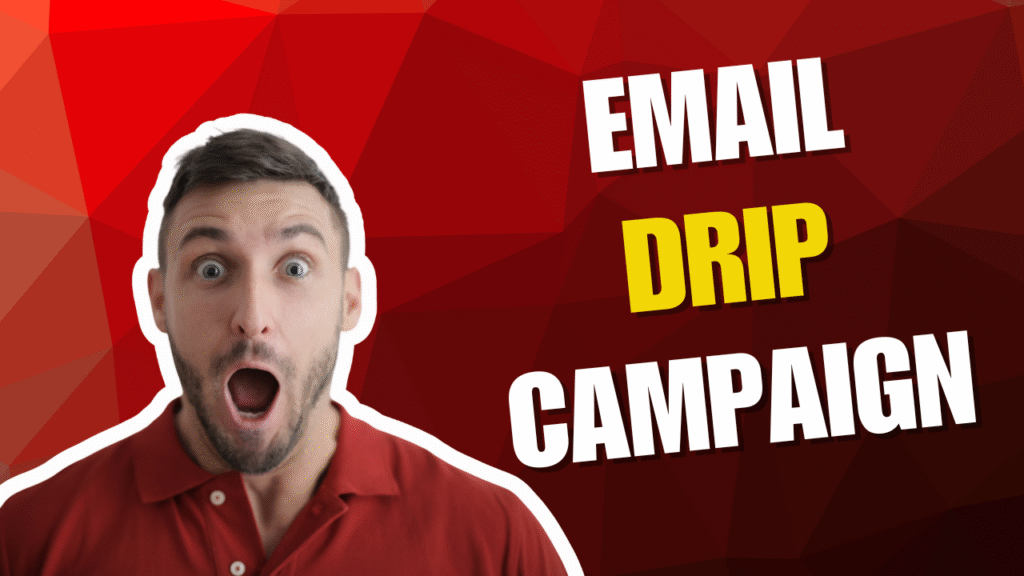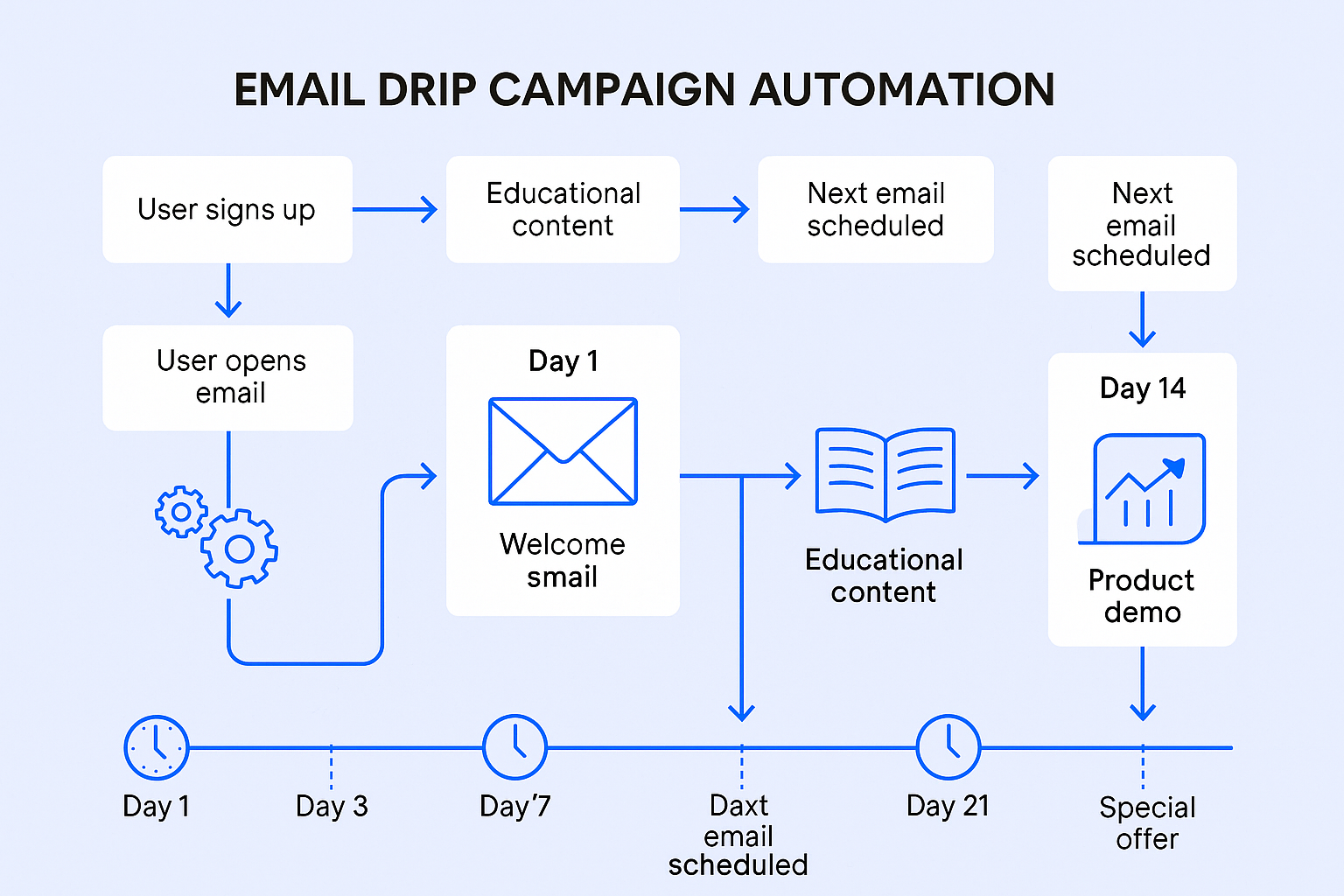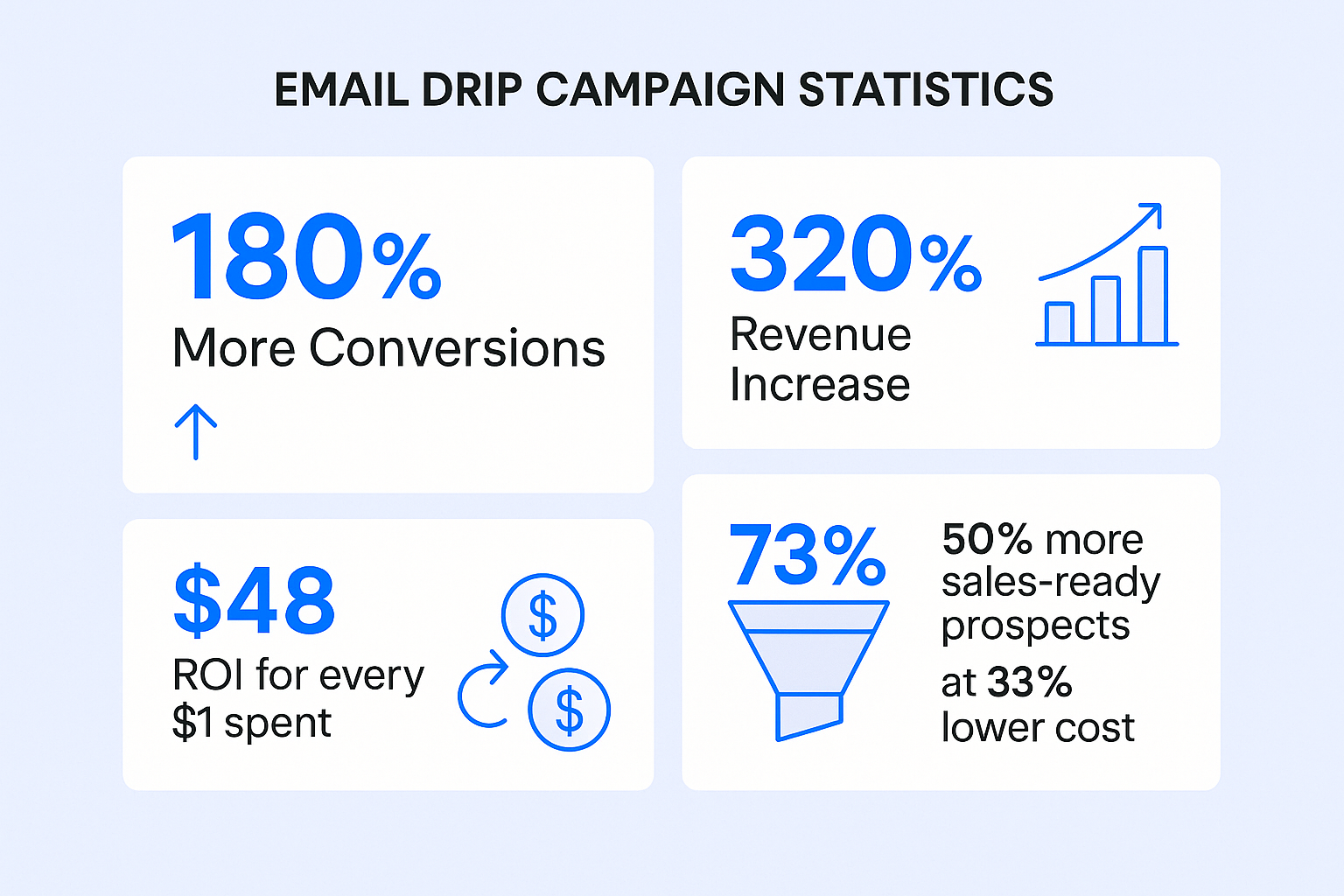- blog
- Email Deliverability
- Email Drip Campaign Guide: Boost Sales with Automation

Email Drip Campaign: Your Complete Guide to Automated Sales Success
Table of Contents
Hey there, sales superstar! Ever feel like you’re playing an endless game of email tag with prospects? You send one message, wait for a response, then scramble to follow up at just the right moment. What if there was a smarter way to nurture those leads while you focus on closing deals?
Enter the email drip campaign – your automated sales assistant that works 24/7. Think of it as having a tireless team member who sends perfectly timed, personalized messages to keep your brand top-of-mind without you lifting a finger after setup.
This guide will show you exactly how to create drip campaigns that convert prospects into customers, from finding high-quality leads to making every email visually irresistible. Ready to supercharge your sales pipeline? Let’s dive in!
What Are Email Drip Campaigns?
An email drip campaign is a series of automated emails sent to subscribers based on specific triggers or predetermined schedules. Unlike one-off email blasts, these campaigns nurture leads through a strategic journey, delivering relevant content at precisely the right moment.
Drip campaigns work like magic because they’re triggered by user actions or time intervals. Common triggers include:
- Signing up for a newsletter or free trial
- Downloading whitepapers or case studies
- Viewing high-value content like pricing pages
- Abandoned cart email sequences for incomplete purchases
- Inactivity periods requiring re-engagement
The real power lies in personalization. Drip email campaigns deliver highly targeted content based on demographics, purchase history, and engagement levels. In fact, emails with personalized subject lines are 27% more likely to be opened, making every message count.
Why Your Sales Team Needs Drip Campaigns
The numbers don’t lie – drip campaigns are conversion machines. They drive 180% more conversions than batch emails and contribute to a 320% increase in revenue. For e-commerce businesses, automated welcome emails achieve nearly 3% conversion rates, while abandoned cart email sequences hit around 2%.
Once set up, email drip marketing campaigns handle the heavy lifting automatically. This frees up BDRs and AEs to focus on high-impact activities like strategic calls and negotiations. It’s like having a force multiplier for your sales efforts.
Here’s the reality: 73% of leads aren’t sales-ready upon first contact. Drip campaigns provide gentle nurturing, guiding prospects through their buying journey at a comfortable pace. Nurtured leads generate 50% more sales-ready prospects at 33% lower cost, plus they result in 47% larger purchases compared to non-nurtured leads.
The ROI speaks for itself – email marketing delivers an average return of $48 for every $1 spent, making it one of the most cost-effective channels for sales teams.
Identify Engaging Leads
Understanding Lead Qualification
Lead qualification is your secret weapon for identifying prospects most likely to become customers. It’s the process of scoring leads based on their fit with your Ideal Customer Persona (ICP) and their likelihood of conversion.
For BDRs and AEs, proper qualification saves massive time and effort by focusing energy only on valuable leads. This prevents wasted cycles on poor-fit accounts and increases overall productivity and conversion rates.
Smart Segmentation Strategies
Not all leads are created equal – some are ready to buy, others are just browsing. Effective segmentation divides your audience into defined groups based on shared characteristics, enabling highly targeted drip email campaigns.
Key segmentation criteria include:
Demographic/Firmographic Data: Job role, company size, industry, geographic region Behavioral Data: Website browsing history, content consumption, past purchases, email engagement patterns Needs-Based Segmentation: Grouping leads by specific problems they’re trying to solve Sales Readiness: Categorizing leads by their position in the customer journey (awareness, interest, consideration, decision)
This strategic approach ensures each email drip campaign delivers precisely relevant content, moving beyond generic outreach to data-driven targeting.
🎯 Why Wait Weeks for Responses?
LinkedIn outbound books qualified meetings while drip campaigns slowly nurture leads
Top Lead Qualification Frameworks
Several proven frameworks help identify hot leads:
BANT (Budget, Authority, Need, Timeframe): Determines if leads have budget, decision-making authority, genuine need, and realistic timeline CHAMP (Challenges, Authority, Money, Prioritization): Focuses on challenges, authority, budget, and urgency ANUM (Authority, Need, Urgency, Money): Emphasizes decision-making power, specific needs, urgency, and available budget FAINT (Funds, Authority, Interest, Need, Timing): Assesses funds, authority, interest level, underlying need, and purchase timing
Complement these frameworks with Lead Scoring – assigning numerical scores based on demographic fit and behavioral intent like website visits, content downloads, and pricing page views. This helps prioritize follow-up efforts for maximum impact.
Connect Your Favorite Email Provider
Essential Email Automation Tools
Managing drip campaigns manually isn’t just difficult – it’s impossible at scale. You need robust email automation software designed specifically for email drip campaigns.
Popular platforms include Mailchimp, ActiveCampaign, Brevo (formerly Sendinblue), HubSpot CRM, Klaviyo, and MailerLite. When selecting a platform, prioritize features like intuitive automation builders (drag-and-drop interfaces are game-changers!), robust segmentation capabilities, and comprehensive analytics.
Many platforms offer free plans, letting you explore functionality before committing to paid subscriptions.
The Power of CRM Integration
Integrating your email marketing platform with your CRM system is transformational for sales workflows. This creates a “single pane of glass” approach, consolidating all customer data and eliminating the need to switch between multiple systems.
CRM integration enables:
- Synchronized lead and contact data for hyper-personalized drip campaigns
- Automated lead scoring and handoffs
- Complete customer interaction tracking
- Reduced administrative burden for sales teams
As leads engage with drip email campaigns (opening emails, clicking links, downloading content), their scores update automatically. Once reaching predetermined thresholds, they’re passed directly to sales teams for follow-up.
The future of email drip campaigns increasingly involves artificial intelligence. AI-powered audience segmentation, conversion predictions, and intelligent automation are becoming standard features. This means smarter personalization, optimal send times, and even determining when email replies need human intervention.
Software | Best For | Key Integrations | Standout Feature |
Mailchimp | Beginners, Small Businesses | Salesforce, Shopify, WooCommerce | Intuitive visual automation builder |
ActiveCampaign | Advanced Marketers | Salesforce, Typeform | Complex workflows and conditional logic |
Brevo | SMBs with Multi-channel Needs | Free Sales CRM, unlimited contacts | Free plan with solid automation |
HubSpot CRM | Free CRM Users | Built-in comprehensive ecosystem | Generous free plan with full features |
Klaviyo | Data-driven eCommerce | Shopify, Magento, Stripe | Powerful analytics and dashboards |
🚀 Supercharge Your Email Campaigns Quality leads drive better results Get verified contacts that convert into customers
Image Personalization for Emails
Why Visual Personalization Matters
In crowded inboxes, generic emails get ignored. Personalized visuals help messages stand out and capture attention effectively. This approach fosters stronger connections and makes customers feel valued and understood.
About 80% of people state that personalized experiences are important for customer satisfaction, and nearly 60% willingly share personal data in exchange for personalized offers.
The impact is measurable: emails with images achieve 4.84% click-through rates compared to just 1.6% for text-only messages. One company using personalized content reported an impressive 88% conversion rate and generated 1,400 leads within 60 days.
Dynamic Image Techniques
Dynamic image tags allow embedding visuals that display unique content tailored to each recipient’s profile, behaviors, or interests. This moves beyond static images to provide personalized visual experiences.
The process involves:
- Audience Segmentation: Based on location, interests, purchases, or engagement levels
- Content Creation: Designing different image variations for each segment
- Dynamic Tag Embedding: Linking image variations to merge tags within email drip templates
- Personalized Delivery: Tags retrieve relevant images when emails open, ensuring recipients see directly relevant content
Specialized tools like Abyssale and NiftyImages facilitate dynamic image creation, enabling personalization at scale with real-time updates and integration with platforms like Mailchimp.
Practical examples include pet stores showing different promotions to “dog lovers” vs “cat lovers,” or Nike displaying gender-specific offers within the same drip campaign. For abandoned cart emails, dynamic images can show exact items left behind, providing highly relevant visual reminders.
Drip Campaign Best Practices
Crafting Your Campaign Journey
Effective drip campaigns strategically map to the customer journey, guiding prospects from awareness through consideration, decision, and retention. Each email should play a specific role in moving customers through the sales funnel.
Content Strategy by Stage:
Awareness Stage: Educational content like blog posts, whitepapers, e-books helping prospects understand problems and solutions Consideration Stage: Case studies, testimonials, product demos, free trials, comparison guides highlighting unique benefits
Decision Stage: Limited-time offers, customer success stories, clear purchase calls-to-action Retention Stage: Thank you emails, exclusive discounts, educational content maximizing recent purchase value
Content That Converts
Successful drip campaigns require clear, targeted messages that resonate with audiences:
Click-Worthy Subject Lines: Compelling, personalized subjects that create urgency when appropriate. Personalized subject lines increase open rates by 27%.
Concise, Valuable Content: Keep emails short and actionable, leading with the most valuable information. Every email should offer clear benefits, not just sales pitches.
Compelling Calls-to-Action: Each email needs clear, persuasive CTAs guiding recipients to the next journey step.
Respectful Frequency: Avoid overwhelming contacts. General guidelines suggest 4-10 emails spaced 4 days to 2 weeks apart. For consumer goods and retail, 5-8 emails per month show highest ROI.
📧No Campaign Setup Required
LinkedIn outbound delivers results without building automation workflows or lead scoring
Key Metrics to Track
Monitor these essential metrics for optimal drip campaign performance:
Metric | What it Measures | Good Benchmark |
Open Rate | Percentage opening emails | >30% (good), 45-50% (strong) |
Click-Through Rate | Percentage clicking links | ~2% average |
Conversion Rate | Percentage completing desired actions | ~3% (welcome emails), ~2% (abandoned cart) |
Bounce Rate | Undeliverable emails | <2% acceptable, <1% ideal |
ROI | Earnings vs. campaign cost | ~$48 for every $1 spent |
Regular assessment, data analysis, and A/B testing of subject lines, timing, and CTAs enable continuous refinement and maximum ROI.
Frequently Asked Questions
How does LinkedIn outbound compare to sophisticated email drip campaigns for B2B sales?
What's the best frequency for drip emails?
How do I know if my drip campaign is working?
Can I use drip campaigns for existing customers?
What's the difference between drip campaigns and email blasts?
Conclusion
Mastering email drip campaigns transforms sales outreach from reactive to strategic. By identifying high-potential leads, leveraging automation tools, and personalizing every touchpoint, you create a systematic approach that nurtures prospects while freeing up time for high-value activities.
The statistics speak clearly: drip campaigns drive 180% more conversions, generate 50% more sales-ready leads at 33% lower cost, and deliver impressive ROI of $48 for every dollar spent. For BDRs and AEs, this isn’t just another tool – it’s a competitive advantage.
Start by implementing lead qualification frameworks, choose integrated email platforms, and focus on creating valuable, personalized content for each journey stage. Remember, successful drip email marketing campaigns begin with quality lead data and strategic thinking.
Your prospects are waiting for the right message at the right time. Give them exactly that with well-crafted email drip campaigns, and watch your pipeline transform from feast-or-famine to consistently full.

Skip Drip Sequences. Book Meetings
LinkedIn outbound connects with decision-makers instantly without complex automation sequences
